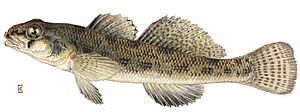Tessellated darter facts for kids
Quick facts for kids Tessellated darter |
|
|---|---|
 |
|
| Conservation status | |
| Scientific classification |
The tessellated darter (Etheostoma olmstedi) is a small, freshwater fish. It belongs to the darter group, which is part of the family called Percidae. This family also includes well-known fish like perches. You can find tessellated darters in rivers and streams in Canada and the United States. This fish looks a lot like another darter called the johnny darter. For a long time, people thought the tessellated darter was just a type of johnny darter.
Contents
What Does the Tessellated Darter Look Like?
Both the tessellated darter and the johnny darter are light in color. They often have small, X- or W-shaped marks on their backs and upper sides. A key feature is that they only have one spine on their anal fin. Most other darters in their home areas have two.
Tessellated darters usually have a slightly pointier snout than johnny darters. They also have more soft rays on their dorsal fin and more rays on their pectoral fins. Their bodies are long but a bit flat from side to side.
Their skin is a pale, sandy color, becoming whitish underneath. Some scales on their upper sides have dark edges, creating wavy lines. Along their middle sides, they have 9 to 11 clear X- and W-shaped marks.
When male tessellated darters are ready to breed, their fins can change color. They develop 12 or 13 even vertical stripes along their sides. The wavy lines and X-shaped marks fade. Their fins might look like they have white bands on a dark background. This is the opposite of how they look when not breeding.
What Do Tessellated Darters Eat?
Young tessellated darters start by eating tiny crustaceans and small insects. As they grow bigger, they switch to eating larger insects. They are important parts of the food web in their freshwater homes.
How Do Tessellated Darters Reproduce?
Male tessellated darters are very protective fathers. They guard the nests of fertilized eggs until the young fish, called fry, can swim on their own. Sometimes, male darters even take care of eggs from other fish that were in their nest before. This is called "alloparental care." It helps the males have more successful offspring.
Interestingly, male darters sometimes eat some of their own eggs or young. This is called "filial cannibalism." Scientists are still studying why they do this.
Where Does the Name Come From?
The tessellated darter was first officially described in 1842. This was done by an American fish expert named David Humphreys Storer. He found the first examples of this fish in the Connecticut River in Hartford, Connecticut.
The fish's specific name, olmstedi, honors Charles H. Olmsted. He was the person who collected the first fish specimens. Charles H. Olmsted was also the president of the Hartford Natural History Society. This darter is closely related to the Johnny darter (E. nigrum). For some time, people thought they were the same species.


